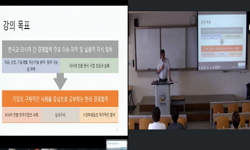The shrines of the taz include the hunting shrine laopatu, the village shrine Laoinfu, and the family shrine laoyemao(myo). Depending on the location, the hunting shrine is at the upper level, the village shrine is at the middle level, and the family ...
http://chineseinput.net/에서 pinyin(병음)방식으로 중국어를 변환할 수 있습니다.
변환된 중국어를 복사하여 사용하시면 됩니다.
- 中文 을 입력하시려면 zhongwen을 입력하시고 space를누르시면됩니다.
- 北京 을 입력하시려면 beijing을 입력하시고 space를 누르시면 됩니다.
https://www.riss.kr/link?id=A109600562
- 저자
- 발행기관
- 학술지명
- 권호사항
-
발행연도
2025
-
작성언어
Korean
- 주제어
-
KDC
300
-
등재정보
KCI등재
-
자료형태
학술저널
- 발행기관 URL
-
수록면
255-270(16쪽)
- 제공처
-
0
상세조회 -
0
다운로드
부가정보
다국어 초록 (Multilingual Abstract)
The shrines of the taz include the hunting shrine laopatu, the village shrine Laoinfu, and the family shrine laoyemao(myo). Depending on the location, the hunting shrine is at the upper level, the village shrine is at the middle level, and the family shrine is at the lower level, so these shrines have a triple structure of upper, middle, and lower levels. The hunting shrines of the taz are of two types: the sacred tree shrine and the rock shrine. The central god is Sanshinye, the god of the mountains, and the purpose is to pray for the success of hunting and wild ginseng gathering for individual and economic interest groups (hunters and wild ginseng gatherer). The village shrines of the taz, laoinpu, are located in the mountains or on a floor of mountain. The central gods are the mountain god Sansinye and the village god laopatu, and the purpose is to protect the village, and the main subjects are the members of the village community. The family shrine laoyemao(myo) is a shrine for the family community. The central gods are laopatu, the village god, and loipu, the ancestor god, and here, Sobo rite in the funeral and ancestor god worship ceremonies are performed. The religion of the taz developed in the order faith in a god of heaven → faith in a mountain god → faith in a village → faith in a family god ,, and their shrines developed in the order a hunting god shrine → a village god shrine → a family god shrine. This shows the process by which their religions and shrines developed and transformed according to the geography, topography, lifestyle, and worldview of their residential areas. In the religion of taz complexly hybrids and fuses the ideas of various ethnic groups and tribes, including the Han Chinese, indigenous people of northeastern China, Manchuria-Tungus, and Koreans, as well as various ideas from different eras, such as heavenly gods, mountain gods, village gods, and ancestor worship.
동일학술지(권/호) 다른 논문
-
농민조직을 활용한 농촌개발 ODA 사업의 성과와 한계: 베트남 뚜옌꽝성 사례를 중심으로
- 한국아시아학회
- 이두리
- 2025
- KCI등재
-
이주노동자의 주거실태 및 주거환경 개선방안 - 산업 및 직업을 중심으로 -
- 한국아시아학회
- 이옥자
- 2025
- KCI등재
-
코로나19 이후 한국과 일본의 여가산업 트렌드 비교분석: 2023년 한·일 여가백서를 중심으로
- 한국아시아학회
- 송금희
- 2025
- KCI등재
-
- 한국아시아학회
- 추영민
- 2025
- KCI등재





 DBpia
DBpia



